How to make biofuel with your own hands from manure at home
Modern technologies for processing all kinds of raw materials open the prospect of successfully solving the problem of obtaining biofuels from manure directly at home. Moreover, making biofuel with your own hands at home thanks to the new principles of waste processing, you can simultaneously produce fertilizers for agricultural plantations.
And what is needed for this and how to make a bioreactor correctly - we will consider these issues in detail in our article. We will give recommendations on choosing the best raw materials for biogas production, we will analyze the features of the use of the resulting fuel for household needs.
Of course, the easiest way is to purchase ready-made industrial plants. However, their high cost makes them consider the options for manufacturing production systems with their own hands.
The content of the article:
Briefly about the definition of biogas
According to scientific definitions, biogas is a product obtained as a result of the fermentation process of a mass of biological waste. In this case, the product of fermentation is methane or hydrogen.
The formation of methane (or hydrogen) occurs as a result of the activity of three types of bacteria:
- hydrolysis;
- acid forming;
- forming methane.
The quality of the fermentation product is the composition of the gas mixture, the contents of which are distributed in the ratio: 50-85% methane, 15-50% carbon dioxide, and less than 5% hydrogen sulfide.
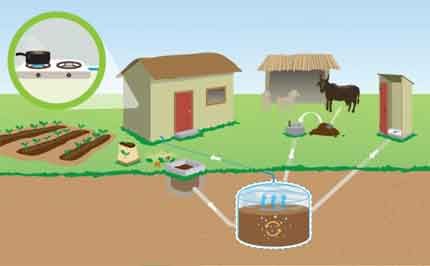
This gas mixture is passed through filters to remove CO.2 and H2S, after which pure biological methane remains. Such gas is no different from natural gas used in the domestic and industrial sectors.
The raw materials for obtaining a high-quality biological gas mixture are usually:
- manure and bird droppings;
- alcohol production waste (bard);
- surplus brewing industries (brewer's grains);
- fecal mass and fish waste;
- beet pulp, household waste, grass and more.
This is only part of all acceptable raw materials for use. But even this list shows: how diverse is the list of raw materials in order to be able to establish biogas production on an ongoing basis.

Volumetric indicators of the gas mixture output directly depend on the type of raw materials used and the dry matter content in it. So, if we apply cattle manure, we can actually get 50-60 m from one ton of manure3 biofuelcontaining up to 60% methane.
It is believed that the best raw materials are waste with a high fat content. Processing one ton of fat waste through a classic biofuel plant can produce up to 1300 m3 gas mixture, where the methane content reaches 90%.
How to make a processing farm module?
In order to make a system for processing waste into biofuel, at least you need to be aware of the principle of operation of such devices, as well as have an idea of circuitry.
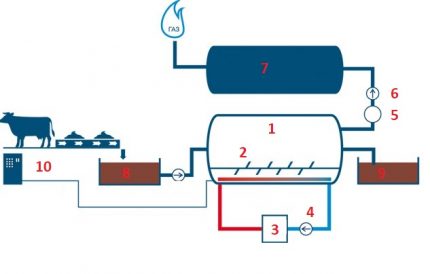
Consider both, but it should be noted: the construction of a full-fledged installation is a rather troublesome and costly business. At home, as a rule, only something similar to the processing stations can be done. However, some attempts are successful.
The principle of biostation
Biofuel production technology, as a rule, supports the following systematic approach:
- The bioreactor (tank) is loaded with manure.
- During a certain time, a fermentation process takes place inside the reactor.
- A gaseous medium is formed.
- The output of gases from the reactor.
- The gas mixture is cleaned and sent for use as fuel.
The composition of the resulting gas mixture is characterized by a sufficiently high saturation with various substances. Most of all in the percentage component is methane (60%), carbon dioxide (35%) and other substances, including hydrogen sulfide (5%).
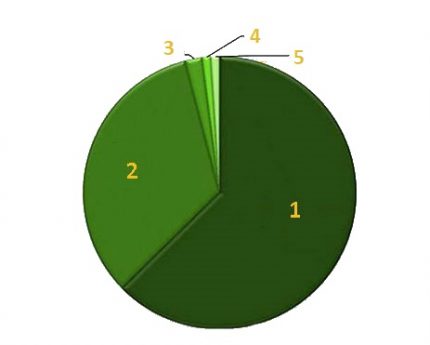
Meanwhile, for the effective operation of the gas-generating station of home production, significant reserves of animal waste are needed.
Therefore, the first thing you should pay attention to when solving the problem of obtaining biofuel in home (cottage) conditions is the availability of sources of raw materials for the processing plant.
DIY bioreactor manufacturing
Having decided on the sources of raw materials, then you need to determine the location of the home (or country) bioreactor. The reactor itself is a sealed vessel, strong enough, having a volume based on the daily supply of manure for processing (for reference: to obtain 100 m3 gas mixture requires about 1 ton of manure).
Table of the ratio of the type of manure and the amount of biogas produced

Such a container will have to be installed on a strong foundation, equipped with shut-off valves and other technical attributes according to the classical scheme. The upper part of the vessel is preferably removable, with bolt fasteners and a gasket.
To ensure continuity of the cycle, the storage tank must be equipped with an artificial heating module. If during the summer period the efficiency of manure fermentation and the rate of gas production are fully ensured by external temperature conditions, in winter the situation changes.
For winter operation of the bioreactor, artificial heating is definitely necessary, given the cessation of the activity of fermentation bacteria already at 4-10 ° C above zero. Accordingly, the tank must have a well-made thermal insulation. For this, the classic method of insulating with mineral wool is well suited.
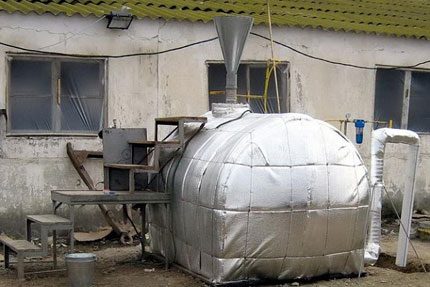
There are several options for organizing heating. For example, the use of electric heaters or a heating system on a water coolant (water jacket).
The power of the heating circuit should be calculated on the basis of the optimal temperature norm inside the reactor of 25-40 ° C, necessary to achieve an effective biomass fermentation process.
In addition to heaters, the degree of stagnation also affects the activity of biomass fermentation. In fact, inside the tank, the manure must always be in motion. The movement of biomass enhances the fermentation process and reduces the time to obtain the gas component.
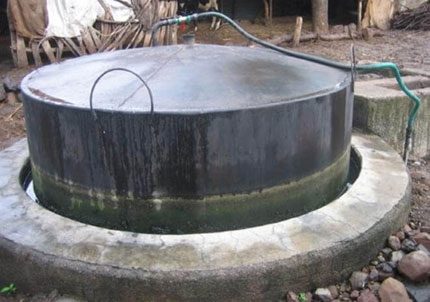
The problem of organizing the movement is solved by introducing a special mechanical mixer into the bioreactor design. The shaft of this device is connected to the shaft of a low-speed motor, which carries out the action of rotation. Turning the mixing process on and off can be done manually or automatically.
We have another article on the site that contains installation instructions for biogas for the needs of a private house.
The process of obtaining biogas and fertilizers
The design of the biofuel production system at home technologically involves loading the vessel with manure at about 1/3 of the capacity. For loading manure, a loading hatch with a hermetically closing door is made. The remaining upper region of the bioreactor is used to accumulate the emitted gases.

At the upper and lower levels of the vessel, you need to make exit holes. At the top there is a gas outlet, at the bottom there is an outlet for the discharge of treated manure (fertilizers). Also in the region of the upper region of the vessel, it is desirable to mount a viewing window for monitoring the process.
The pipe for the output of the gas mixture is connected by a sealed pipe to a device that simultaneously performs the functions of a separator and a water seal. For communication, a pipe (metal or polyethylene) of a small diameter (25-32 mm) is used.
The separator itself is a vessel of relatively small capacity, filled with water. The gas passing through the water column is purified, discharged into gas tank and then served to consumers.
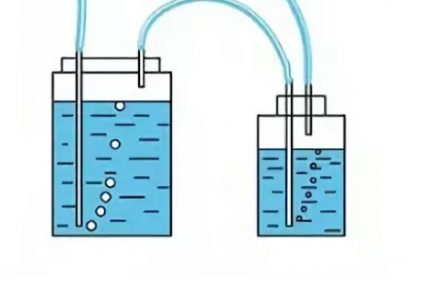
The lower pipe on the reactor (for the withdrawal of spent manure - sludge) is desirable to make the largest possible diameter. Shut-off valves (valves) are connected to it and a tap is made to the tank for collecting sludge. Waste mass in the farm can be successfully used as fertilizer.
Detailed information on the determination of the required capacity volume, as well as on the calculations of the bioreactor performance and the appropriateness of using biogas, we reviewed next article.
What should be the composition of the dung mass?
The loading mass of manure inside the bioreactor should not be regarded simply as raw materials suitable in any quality. The constituent of the substance is of fundamental importance for the fermentation process. In practice, it was noted that a decrease in substrate particles is accompanied by better process efficiency.
The pronounced fibrous nature of the substrate and the increase in the area of interaction of bacteria are the main criteria that contribute to the rapid decomposition of manure. In this state, when heated and mixed, manure does not form a precipitate or film on the surface, which greatly simplifies the filtration of the gas mixture.
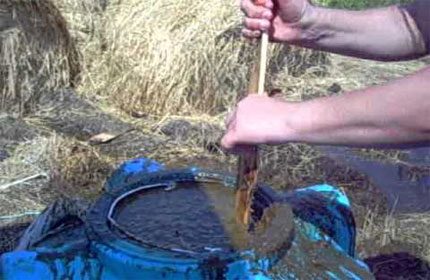
The degree of grinding of raw materials determines the duration of fermentation, which in turn affects the volume of gas produced. Thus, to reduce the fermentation time, it is necessary to grind the raw materials well: the better the grinding quality, the shorter the fermentation period.
Features of the use of biogas for household needs
The scope of this type of energy is quite extensive. Thanks to the use of biogas as a fuel, they produce electric energy, produce hot water or steam. There are numerous examples from practice where automobile transport fuels biofuel.
But, so that there are no problems in the economy when using such fuel, it is extremely important to equip the storage for the biogas obtained, highlighting the right place under the gas holder Location on.
Biogas plants of this type are the equipment that opens up the possibility of creating waste-free production facilities. In this regard, a good example is demonstrated by individual countries of Western Europe.
For example, in Denmark, the production of this type of fuel has reached the level of almost 20% of the country's total energy resources. In large regions of the world - India and China - the expense of biogas plants goes to hundreds of thousands.
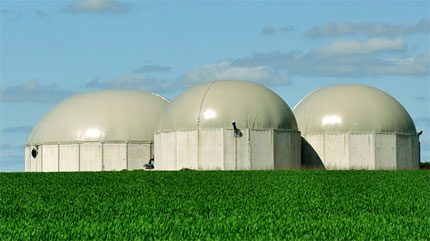
Not just so, there has been a significant increase in worldwide interest in biogas production processes.
This is one of those energy options that are attributed to alternative sources and for which they see the future, so farmers and housing and communal services managers, owners of private households and small enterprises are closely monitoring the development of technology.
Conclusions and useful video on the topic
Overview of the biogas plant, the manufacture of which used a plastic tank of 127 liters. Device features and operating tips.
Of particular interest is the use of the installations among the owners of the restaurant and gastronomic sector, where the topic of food waste processing remains relevant. On this basis, there is a good opportunity to create cheap recycling of organic waste for the benefit of farms.Finally, biofuel production technology is a real conservation of the environment, which cannot be said about the production of other power engineers.
Are you interested in biofuel production and want to clarify some points? Ask controversial questions in the comments - our experts will try to clarify such points.
Or maybe you are not familiar with the manufacture of a bioreactor and the process of producing biogas? Share practical knowledge and your opinion on this issue under our article - many business executives will be interested in your experience and recommendations.

 Biofuel for the fireplace: types of biofuel, its properties + how to choose and how to do it yourself
Biofuel for the fireplace: types of biofuel, its properties + how to choose and how to do it yourself 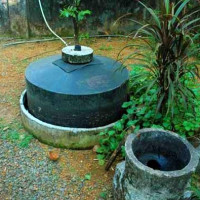 How to get biogas from manure: an overview of the basic principles and design of a production plant
How to get biogas from manure: an overview of the basic principles and design of a production plant  How to make a bio fireplace with your own hands: device, diagrams and step-by-step assembly instructions
How to make a bio fireplace with your own hands: device, diagrams and step-by-step assembly instructions 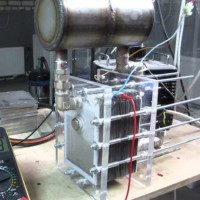 How to make a hydrogen generator for your home with your own hands: practical tips for manufacturing and installing
How to make a hydrogen generator for your home with your own hands: practical tips for manufacturing and installing  DIY bio-fireplace burner: instructions and manufacturing tips
DIY bio-fireplace burner: instructions and manufacturing tips 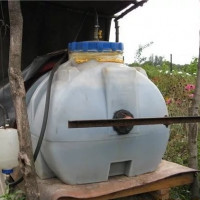 Biogas plant for a private house: recommendations for arranging homemade
Biogas plant for a private house: recommendations for arranging homemade  How much does it cost to connect gas to a private house: the price of organizing gas supply
How much does it cost to connect gas to a private house: the price of organizing gas supply  The best washing machines with dryer: model rating and customer tips
The best washing machines with dryer: model rating and customer tips  What is the color temperature of light and the nuances of choosing the temperature of the lamps to suit your needs
What is the color temperature of light and the nuances of choosing the temperature of the lamps to suit your needs  Replacement of a geyser in an apartment: replacement paperwork + basic norms and requirements
Replacement of a geyser in an apartment: replacement paperwork + basic norms and requirements
I agree that it is very costly and time-consuming. However, I once saw a program on Discovery, which talked about the success of such devices in farms in Sweden. But so far, in my opinion, in Russia this is troublesome and not very profitable. Because the price of energy is quite low, and the effectiveness of such devices in relation to costs is doubtful. I think that so far it would be suitable for home farmers in hard-to-reach regions (in particular, in marshy areas), where there is no gas pipeline, electricity, etc., and then some raw materials need to be provided. But the idea is worthwhile.
Not very profitable for small household plots with small volumes of manure. For large complexes with hundreds of tons, this may make sense, but they see no reason to do something, if everything works like that.
If the gas is odorless, then how to detect a leak?
Biofuel as an alternative to natural gas has long been used in a number of countries on an industrial scale. We are making timid attempts to expand the production and operation of bioenergy plants. Our craftsmen, as always, ahead of the heavy (on the rise) industry, already rivet them with might and main.
The productivity of homemade plants is small, but for the farmers they are just right. At the farm, the gas received, for example, will be consumed for heating in the winter, heating water, and preparing feed. A shower for people is the blue dream of milkmaids.
In my opinion it is profitable. It’s possible not only manure but leaves, grass, hay, weeds, kitchen waste and human waste, instead of a cesspool in the Belarusian State University, and fertilizer and gas at the outlet. If a BSU is installed in the greenhouse, then carbon dioxide will come in handy. Also, why build unprofitable windmills and solar panels a battery for them ... When the generator buy and there will be electricity and gas as a by-product and good fertilizer. More profitable than pipelines to small villages.
Interestingly, no one tried to use hogweed as raw material instead of corn silage ...